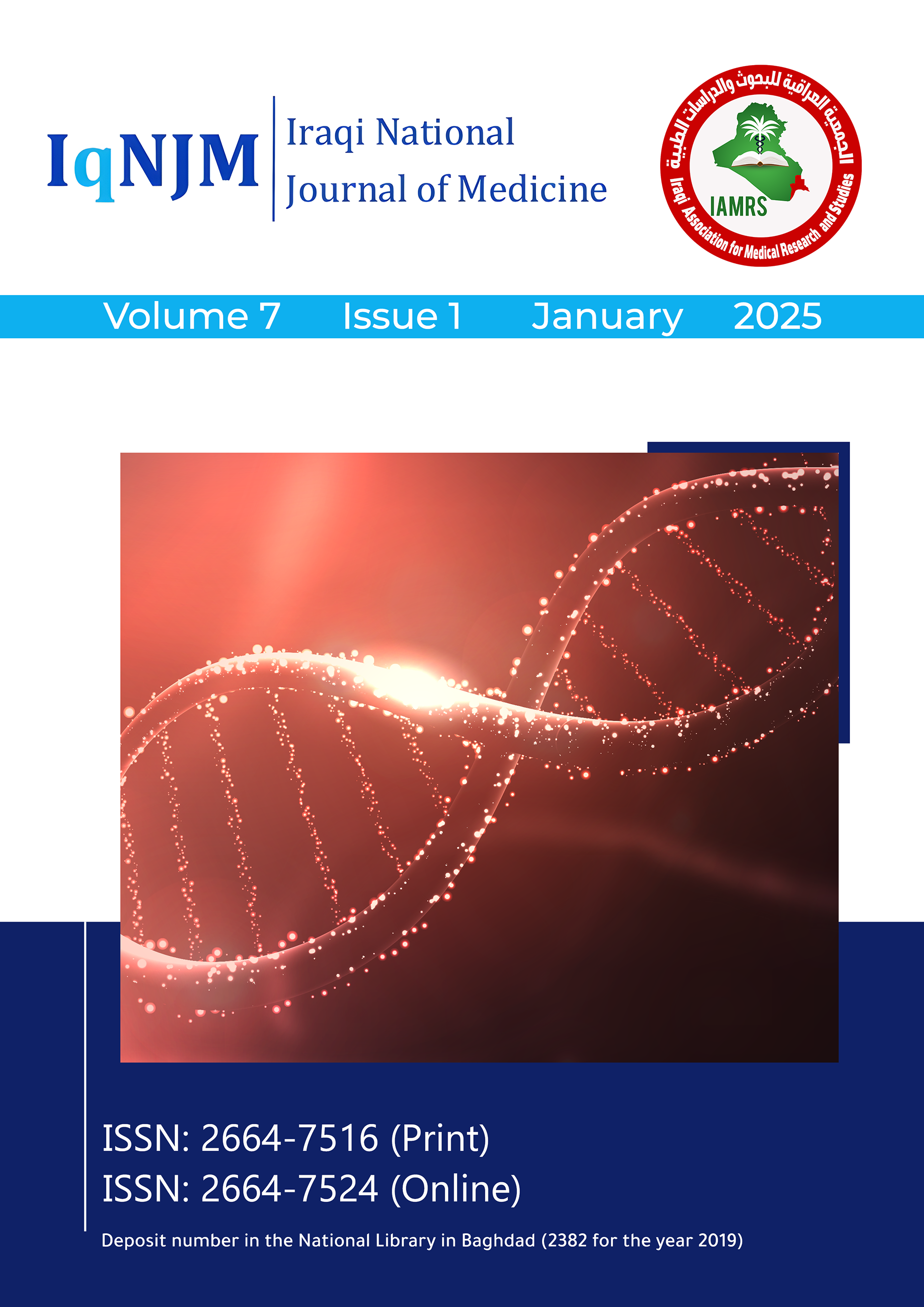Distribution of resistance genes among carbapenem-resistant Acinetobacter baumannii isolated from different clinical specimens
Main Article Content
Keywords
Acinetobacter baumannii, carbapenem resistance, carbapenemase, PCR
Abstract
Background: Carbapenems are the drugs of choice for serious hospital-acquired infections and for patients in intensive care unit affected by multidrug-resistant microorganisms, particularly Acinetobacter baumannii. Carbapenem-resistant Acinetobacter baumannii (CRAB) poses a significant threat to public health. Aim: The study aims to focus the distribution of carbapenemase-encoding genes belonging to classes A and B (blaGES, blaKPC, and blaNDM) among CRAB isolated from various clinical specimens. Methods: A total of 55 bacterial isolates were collected from different clinical specimens and underwent identification using Chrom agar and the Vitek 2 compact (ID) system. The checkerboard technique, modified Hodge test, and Vitek 2 compact (AST) system were employed to detect CRAB. PCR techniques were used to identify the presence of blaGES, blaKPC, and blaNDM. Results: Of the 55 isolates, 43 (78.1%) were identified as A. baumannii, with 39 (90.6%) of these being CRAB. All CRAB isolates could produce carbapenemase. The percentages of CRAB isolates possessing blaGES, blaKPC, and blaNDM were 28.2%, 15.4%, and 48.7%, respectively. In contrast, 25%a percentage of non-CRAB isolates possessing blaKPC and blaNDM had 25% of each. Conclusion: A high prevalence of CRAB capable of producing carbapenemase and harboring blaGES, blaKPC, and blaNDM genes belonging to classes A and B was observed among various infections in Al Najaf hospitals.
References
2. Nordmann P, Poirel LJCID. Epidemiology and diagnostics of carbapenem resistance in Gram-negative bacteria. Clin Infect Dis. 2019; 69(7):S521-S528. DOI: 10.1093/cid/ciz824
3. Ejaz H, Ahmad M, Younas S, Junaid K, Abosalif KOA, Abdalla AE. Molecular epidemiology of extensively-drug resistant Acinetobacter baumannii sequence type 2 co-harboring bla NDM and bla OXA from clinical origin. Infect Drug Resist. 2021;1931-39. DOI: 10.2147/IDR.S310478
4. Fournier PE, Richet H, Weinstein RAJC. The epidemiology and control of Acinetobacter baumannii in health care facilities. Clin Infect Dis 2006; 42(5):692-99. DOI: 10.1086/500202.
5. Ramirez MS, Bonomo RA, Tolmasky MEJB. Carbapenemases: Transforming Acinetobacter baumannii into a yet more dangerous menace.
Biomolecules. 2020; 10(5): 720. DOI: 10.3390/biom10050720
6. Harding CM, Hennon SW, Feldman MF. Uncovering the mechanisms of Acinetobacter baumannii virulence. 2018; 16(2):91-102. Nat Rev Microbiol.
DOI: 10.1038/nrmicro.2017.148.
7. Sheldon JR, Skaar EPJ. Acinetobacter baumannii can use multiple siderophores for iron acquisition, but only acinetobactin is required for virulence.
PLoS Pathog. 2020;16(10), e1008995. DOI: 10.1371/journal.ppat.1008995.
8. Abbott I, Gustavo MC, Saruar B, Anton YP. Carbapenem resistance in Acinetobacter baumannii: laboratory challenges, mechanistic insights, and therapeutic strategies. Expert Rev. Anti-Infect Ther. 2013; 11(4):395-409. DOI: 10.1586/eri.13.21.
9. Selvaraj A, Valliammai A, Sivasankar C, Suba M, Sakthivel G, Pandian SKJSR. Antibiofilm and antivirulence efficacy of myrtenol enhances the antibiotic susceptibility of Acinetobacter baumannii. Sci Rep. 2020; 10(1):21975. DOI: org/10.1038/s41598-020-79128-x
10. Yong D, Lee K, Yum JH, Shin HB, Rossolini GM, Chong YJ. (2002). Imipenem-EDTA disk method for differentiation of metallo-β-lactamase-producing clinical isolates of Pseudomonas spp. and Acinetobacter spp. Clin Microbiol. 2002; 40(10):3798-3801. DOI: 10.1128/JCM.40.10.3798-3801.2002.
11. Lee K, Chong Y, Shin H, Kim Y, Yong D, Yum JJCM. Modified Hodge and EDTA-disk synergy tests to screen metallo-β-lactamase-producing strains of Pseudomonas and Acinetobacter species. Clin Microbiol Infect. 2001; 7(2): 88-91. DOI: 10.1046/j.1469-0691.2001.00204.x
12. Ranjbar R, Afshar D. Evaluation of (GTG) 5-PCR for genotyping of Klebsiella pneumonia strains isolated from patients with urinary tract infections. Iranian Journal of Public Health. 2019;48(10).
13. Amudhan S, Sekar U, Arunagiri K, Sekar BJIJ. OXA beta-lactamase-mediated carbapenem resistance in Acinetobacter baumannii. Indian J Med Microbiol. 2011; 29(3):269-274. DOI: 10.4103/0255-0857.83911.
14. Moubareck C, Brémont S, Conroy MC, Courvalin P, Lambert TJA. GES-11, a novel integron-associated GES variant in Acinetobacter baumannii. Antimicrob Agents Chemotherapy. 2009; 53(8): 3579-3581. DOI: 10.1128/AAC.00072-09.
15. Soudeiha MA, Dahdouh EA, Azar E, Sarkis DK, Daoud ZJF. In vitro evaluation of the colistin-carbapenem combination in clinical isolates of A. baumannii using the checkerboard, Etest, and time-kill curve techniques. Front Cell Infect Microbiol. (2017);7:209.
DOI: 10.3389/fcimb.2017.00209.
16. Chuang YC, Sheng WH, Li SY et al. Influence of genospecies of Acinetobacter baumannii complex on clinical outcomes of patients with Acinetobacter bacteremia. Clin Infect Dis. 2011;52(3):352-360. DOI: 10.1093/cid/ciq154.
17. Peleg AY, Seifert H, Paterson DL. Acinetobacter baumannii: Emergence of a successful pathogen. Clin Microbiol Rev. 2008;21:538-582.
DOI: 10.1128/CMR.00058-07.
18. Almasaudi SB. Acinetobacter spp. as nosocomial pathogens: epidemiology and resistance features. Saudi J Biol Sci. 2018;25:586-596. DOI: 10.1016/j.sjbs.2016.02.009


